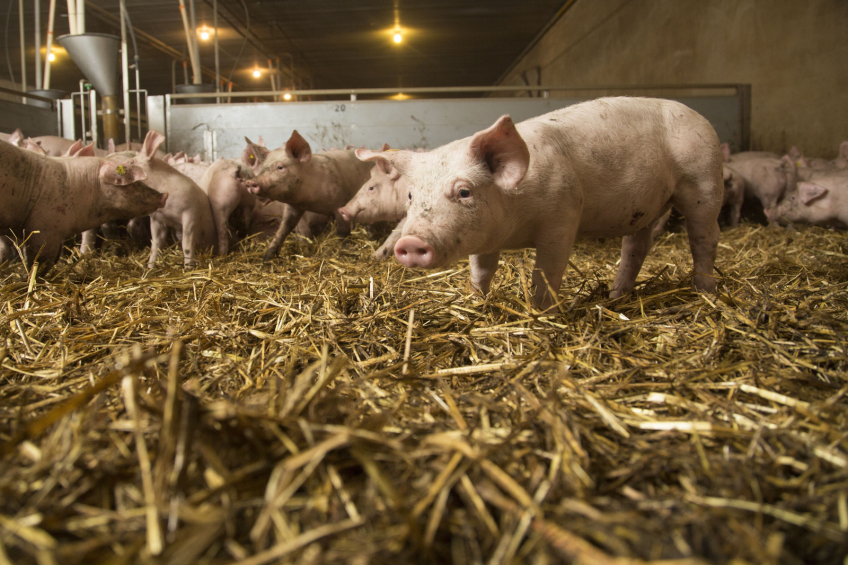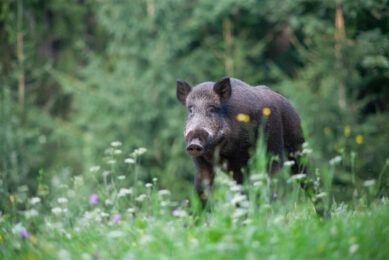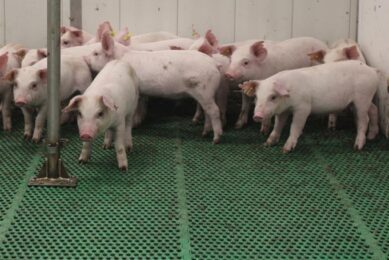The role of zinc in piglet health

Zinc can be used in two ways in piglets – as an essential nutrient (in low dosage) and as a therapeutic treatment (in high dosage) to prevent diarrhoea occurrence. How exactly does it work and what does the future hold for zinc in food animals?
By David Burch, veterinarian, Octagon Services, UK
“Zinc is the trace element involved in more biological functions than any other micro-mineral in the nutrition of the newly weaned pig.” Such was the first sentence of a recent academic work published by well-known US scientist Dr Gretchen Hill in the Journal of Animal Science, earlier in 2014. Indeed, zinc is an essential mineral nutrient for the health and growth of young piglets and is recognised as such in the European Union (EU) and is permitted up to 150 ppm in pig feed diets.
Zinc has sometimes been called a ‘growth promoter’, in almost an attempt to slander it by some authors, but in a 2003 report by the European Commission, inclusion levels of zinc up to 250 ppm showed no significant differences in performance. The only situations where improved growth performances with zinc have been observed were in piglets post-weaning.
Therapeutic use
This leads on to the therapeutic use of zinc oxide (2,500 ppm zinc; 3,100 ppm zinc oxide) for the prevention of post-weaning diarrhoea and occasionally oedema disease, both associated with infections with Escherichia coli. The prevention of disease in piglets does dramatically improve growth and feed conversion efficiency, by preventing post-weaning diarrhoea and even mortality.
This is an area of great debate at the moment, as some EU member states permit its use and some do not, as they are concerned about environmental contamination and long term accumulation of zinc in soil and its potential run off into water.
As a result, where therapeutic zinc oxide is not approved for use, antibiotics are commonly being used to control E. coli infections post-weaning. Recently these antibiotics, such as colistin, have hit the headlines over antimicrobial resistance, as they are becoming the last-resort drugs in human medicine to control gram-negative infections where fluoroquinolones, cephalosporins and carbapenems are now resistant.
Post-weaning diarrhoea
When pigs are weaned, there are major changes in their lives and frequently these result in a growth check at least, frequently diarrhoea and occasionally death. At weaning, pigs are going from primarily a milk diet from the sow which contains protective antibodies against the various micro-organisms in the environment. They may have received creep feed but basically they are going on to a new solid diet, which they have to get used to. They may be moved, vaccinated and mixed with other pigs from other litters so start fighting to establish a pecking order. They will not have the comfort of mother but are likely to go into a new flat-deck pen system with slatted floors, have to find their feed and adjust to drinking water from bowls or nipples. Hopefully, the environmental temperature will be high and not fluctuating to let them cope with the changes. All-in-all, it causes the piglet a great deal of stress adjusting to the new environment and if they are weaned at about 21 days of age they usually will start scouring five days after weaning and the loss of condition or growth check will carry on until about 35 days of age.
The first use of zinc oxide could be seen in the 1990s. Medicines alone were not the answer, as management improvements, nutrition, all had roles to play. Zinc oxide introduction into the peri-weaning diets was miraculous in the way the diarrhoea problems disappeared.
Since the introduction of four-week weaning there has been also a decrease in the severity of post-weaning diarrhoea and after seven days the pigs have recovered and are growing again unlike the 14 days at three-week weaning. Weaning into straw also solved a lot of problems, as it reduced some of the environmental and temperature control stresses.
Since then, most weaner diets in the UK have contained zinc oxide. If it is inadvertently left out of the diet, the diarrhoea and mortality returns promptly. From a veterinary perspective, it has made a huge difference to our management of post-weaning diarrhoea, which is complex and the problem involves many factors. It has also helped reduce antibiotic use.
How does zinc oxide work?
For long, it has been thought that zinc oxide must have an antibacterial effect, especially against E. coli. Danish researchers showed that it had an antimicrobial activity in vitro (Aarestrup & Hasman, 2004) but they had to dissolve the zinc chloride they used in acid and bring the pH down to 5.5 to get it to dissolve. It did have an action against E. coli, various Salmonella species, Staphylococcus aureus and a more mixed action against Enterococcus species. One could therefore assume that it worked in an acid environment especially, probably in the stomach and prevented bacteria entering the gut.
Work by Højberg and others (2005), however, looked at the effect of high levels of zinc (2,500) on the gut flora of the pig in comparison with nutritional levels (100 ppm). Zinc at 2,500 ppm was actually found to increase the pH in the stomach and significantly so in the ileum and caecum but not in the colon. It significantly increased the coliforms (E. coli) in the stomach (did not kill them) and also in the caecum and colon. Similarly, it increased the enterococci species in the gut but significantly reduced the lactobacilli, which are meant to be the good bacteria that prevent diarrhoea, seeTable 1.
Other investigators (Roselli and others, 2003) showed that zinc oxide reduced bacterial adherence of enterotoxigenic E. coli (ETEC) strain K88 (F4) and blocked bacterial invasion by preventing increased tight junction permeability and modulating cytokine gene expression, particularly the increase of inflammatory cytokines and decrease in anti-inflammatory ones.
Zinc oxide’s mode of action may not be a direct antibacterial effect, as previously presumed.
Efficacy of zinc oxide
Several trials have been carried out to test the efficacy of the compound to determine which was the optimum inclusion rate. A summary of ten trials showed the dose-titration effects of zinc on average daily gain, displayed in Figure 1.
Low dose rates of zinc actually showed that it was not a growth promoter as it did not improve growth rate, but when the concentration in food increased to 1,500 ppm there was a marked, positive response, confirming its therapeutic effect using growth rate as an objective indicator. It appeared to peak at 2,500 ppm of zinc giving an average 16% improvement in growth rate.
Once the pigs were over the post-weaning period the growth improvement was often reduced and sometimes turned negative in comparison with controls by three to four weeks post-weaning. The recommended inclusion is for two weeks over the weaning period. Some farmers keep it in longer but by four weeks the improvement has dissipated.
Toxicity of zinc
The absorption of zinc oxide is relatively low at about 14% of the dose so the majority (86%) is excreted via the faeces. Distribution is primarily to the liver and kidneys, and there are only low levels in muscle and bone. Blood levels increase related to dose above 1,000 ppm inclusion. The absorbed zinc is excreted via the urine (0.25%) and the remainder of the absorbed material is retained in the body. Blood levels >3µg/ml are associated with growth depression but this usually occurs with other zinc salts, rather than the oxide. Care must be taken not to overdose or feed for too long a period.
Environmental impact
This is a great area for debate over the use of zinc oxide. It is approved for therapeutic use in countries like the UK, Ireland, Spain, Denmark, USA and recently Belgium have approved its use, providing zinc levels in other pig feeds are reduced. Germany and the Netherlands do not permit it and France is still deciding.
Zinc is a metal and relatively insoluble, so spreading manure containing zinc oxide might accumulate in the soil. Some might run off apparently, especially in sandy, acid soils as it increases the zinc solubility. An EFSA report (2012) described, that ‘concerning the terrestrial environment the predicted environmental concentrations (PECs) in soil, simulated over a period of 50 years of manure spreading, did not exceed the predicted no effect concentrations (PNECs) for terrestrial species in any model scenario developed’. This did not apply to sandy, acidic soils and the water compartment where PNECs might be exceeded in ten years.
However, just using zinc at 2,500 ppm in the peri-weaning period, surprisingly, can increase the zinc output for a breeder/ finisher unit by about 70%, so consideration of manure disposal must be made. It is interesting though that in Denmark they found that the zinc content of pig manure did not exceed levels found in human waste, so were permitted to use it.
Resistance issues
Assuming that zinc oxide had an antimicrobial effect has led to a number of attacks concerning resistance. One report associated zinc with methicillin-resistant Staphylococcus aureus (MRSA) CC398 in Denmark (Aarestrup and others, 2010). They found that 74% of Danish MRSA strains carrying the mecA gene were also resistant to zinc. Methicillin susceptible isolates (MSSA) did not show resistance. They thought that zinc compounds may be partly implicated in the emergence of MRSA clones. All of the MRSA and MSSA isolates were resistant to tetracyclines and 43% to erythromycin. Due to the poor solubility of zinc oxide and the lack of effect on bacteria in the gut it would appear unlikely that sufficient concentrations would be achieved in the nose to have any effect. It has been also used in the UK for over 20 years and MRSA have not evolved. Moodley and others (2011) also showed that the czrC gene (encoding for resistance to cadmium and zinc) was present in the SCCmec elements but the tetracycline resistance genes (tet(K) & tet(M) were on mobile genetic elements, possibly plasmids. Both compounds appeared to increase the numbers of MRSA in the nose but the spread to other pigs was not influenced by treatments of the feed with zinc or tetracyclines.
In a 2013 paper from Germany, Bednorz and others demonstrated that there was a higher incidence of multiresistant E. coli in pigs fed zinc oxide than controls.
The relative number was small (2%) and it was not reported if it was statistically significant or not. The E. coli were resistant to amoxicillin, tetracyclines and trimethoprim/ sulphas. In Canada, a very extensive study of 36 swine barns (Medardus and others, 2014) reported that Salmonella species, which had the multi-resistance type genes to amoxicillin, chloramphenicol, streptomycin, sulphonamide and tetracycline were more likely to carry zinc resistance also in comparison with other multi-resistance genes.
To put this back into context – if resistance was such a major issue why does zinc oxide work still after 20 years of use? In addition, if you put tetracycline and many of the other antimicrobials into the gut there will be a rapid and extensive resistance development within a couple of days, possibly 80-100% resistance in the case of tetracyclines.
Conclusions
No doubt, the debates will continue. Nevertheless, zinc oxide inclusion in feed in the peri-weaning diets has improved pig health and welfare enormously over at least 20 years. As a consequence it has improved growth. It should not be classified as a growth promoter but as a therapeutic agent, which prevents diarrhoea and post-weaning enteric disturbances greatly. I am still not quite sure how it works.
The effect on the environment is still an issue but with care could be managed both from the concentration of zinc in the manure and avoidance of spreading on sandy acid soils.
Zinc as a selector for resistance or multi-resistance is an interesting topic but in relation to the use of antibiotics directly and especially those of increasing human importance such as colistin, the downside risks appear to be minimal. Every EU member state will have to work out their own risk/ benefit strategy. Those billions of pigs that have received zinc oxide in their feed to prevent post-weaning diarrhoea have received a major benefit with minimal risk.
[Source: Pig Progress special – Piglet Health, 2014]











